Opel Corsa B 1993–2000 Service and Repair Manual: 2E3 carburettor - adjustments
Note: Under normal operating conditions only the carburettor idle adjustments will need attention. Checking and adjustment of the following settings is not a routine operation and should only be necessary after carburettor overhaul or if the operation of the carburettor is suspect.
Adjustments with carburettor fitted
Fast idle
1. The engine must be at operating temperature and the idle speed and mixture must be correctly adjusted. Remove the air cleaner to improve access.
2. Position the fast idle adjustment screw on the second highest step of the fast idle cam.
Connect a tachometer to the engine. Make sure that the choke plate is fully open.
3. Start the engine without touching the throttle pedal and compare the engine speed with that given in Specifications. If adjustment is necessary, remove the tamperproof cap from the head of the fast idle screw by crushing it with pliers and adjust by means of the screw (see illustration).
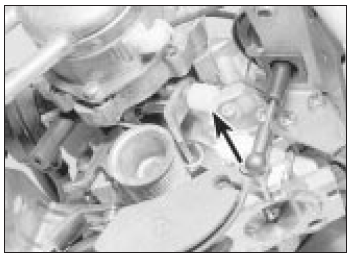
Fast idle adjustment screw under
tamperproof cap (arrowed)
4. When adjustment is correct, stop the engine and disconnect the tachometer. Fit a new tamperproof cap where this is required by law.
Choke pull-down
Note: This adjustment can also be done with the carburettor removed.
5. Remove the air cleaner.
6. Remove the choke cover by removing the three screws and the securing ring. There is no need to disconnect the coolant hoses, just move the cover aside. Notice how the loop in the end of the bi-metallic spring engages in the choke drive lever (see illustration).
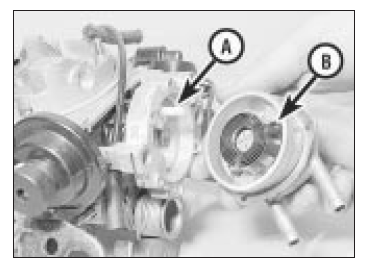
Choke drive lever (A) engages with
loop (B)
7. Move the choke drive lever to close the choke valve completely. Position the fast idle screw on the highest step of the cam.
1.3 litre models
8. Apply vacuum to the choke pull-down unit (at the hose nearest the carburettor body) using a modified hand pump or by making a connection with a rubber hose or plastic tube between the choke vacuum unit of the carburettor and the inlet manifold of another vehicle (engine running). Apply light pressure to the choke drive lever in a clockwise direction (as if to close the choke valve) and check the choke valve gap by inserting a gauge rod or twist drill of the specified size. If adjustment is necessary, turn the adjusting screw on the side of the choke housing (see illustrations).
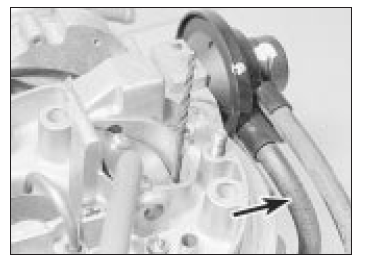
Checking the choke pull-down gap.
Apply vacuum to hose arrowed
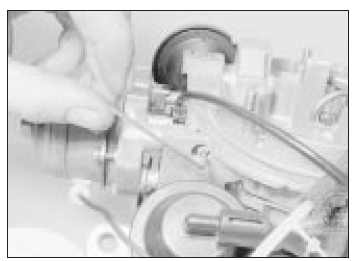
Choke pull-down adjusting screw
1.4 and 1.6 litre models
9. Disconnect both vacuum hoses from the pull-down unit then, using a small screwdriver, press in the pull-down arm adjusting screw until some resistance is felt. In this position the choke valve gap should correspond to the value given in the Specifications for the 'small' gap. Adjust if necessary by turning the screw on the pull-down unit.
10. Press in the screw further until the arm moves to its stop. In this position the choke valve gap should correspond to the value specified for the 'large' gap. Adjust if necessary by turning the arm adjusting screw.
All models
11. Refit the choke cover, making sure that the spring loop engages in the choke drive lever. Align the notches in the choke cover and choke housing when tightening the screws (see illustration).
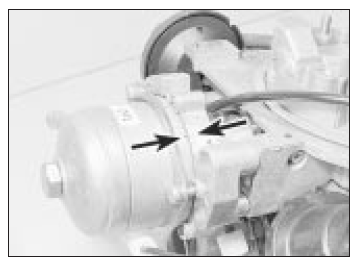
Choke cover alignment marks (arrowed)
Throttle damper adjustment - automatic transmission models
12. To adjust the damper, slacken the locknut and screw the damper in or out until there is a clearance of 0.05 mm between the end of the damper and the throttle lever. From this position, screw the damper towards the throttle lever by 21⁄2 turns, then secure it with the locknut.
Adjustments with carburettor removed
Fast idle cam position
13. The choke pull-down adjustment previously described must be correct. If not already done, remove the choke cover.
14. Open the throttle, then close the choke valve by light finger pressure on the choke drive lever. Release the throttle.
15. Check that the fast idle adjustment screw is resting on the second highest step of the fast idle cam, in the position shown (see illustration). If not, first check that the choke return spring is correctly positioned. then adjust by bending the lever 2.
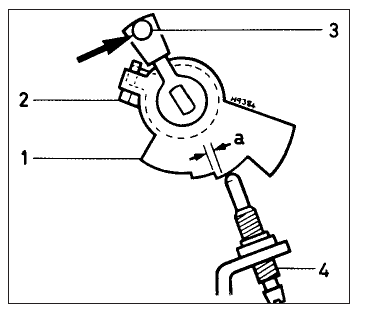
Fast idle cam adjustment
- Fast idle cam
- Adjustment lever
- Choke drive lever (press in direction arrowed)
- Fast idle adjustment screw a = 0.2 to 0.8 mm
16. Refit and secure the choke cover, observing the alignment marks.
Throttle valve fast idle gap
17. Position the fast idle adjustment screw on the highest step of the fast idle cam.
18. Use a gauge rod or twist drill of the specified diameter to measure the opening of the primary throttle valve. Adjust if necessary at the fast idle adjustment screw. (This is a preliminary adjustment; final adjustment of the fast idle speed should take place with the engine running.)
Accelerator pump delivery
19. It will be necessary to feed the float chamber with fuel from a small reservoir during this test. Take all necessary fire precautions when dealing with fuel and fuel vapour.
20. Position the primary barrel over an accurate measuring glass. Fully open and close the throttle ten times, taking approximately one second for each opening and pausing for three seconds after each return stroke. Make sure that the fast idle cam is not restricting throttle travel at either end.
21. Measure the quantity of fuel delivered and compare it with the specified value.
22. If adjustment is necessary, release the clamp screw and turn the cam plate in the desired direction (see illustration). Tighten the clamp screw and recheck the pump delivery.
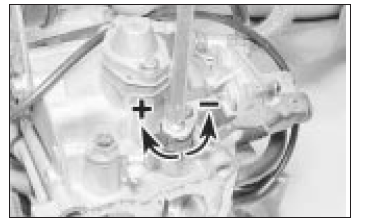
Accelerator pump delivery
adjustment: + to increase, - to decrease
 1B1 carburettor - adjustments
1B1 carburettor - adjustments
Note: Under normal operating conditions only the
carburettor idle adjustments will need attention. Checking and
adjustment of the following settings is not a
routine operation and should only be
...
 Varajet ll carburettor -
adjustments
Varajet ll carburettor -
adjustments
Note: Under normal operating conditions only
the carburettor idle adjustments will need attention. Checking and
adjustment of the following settings is not a
routine operation and should only be
n ...
See also:
Opel Corsa Owners Manual. Fuel consumption - CO2-Emissions
The determination of fuel
consumption is regulated by
European directive 80/1268/EEC
(latest edition 2004/3/EC).
The directive is oriented to actual
driving practices: Urban driving is
rated at ...
